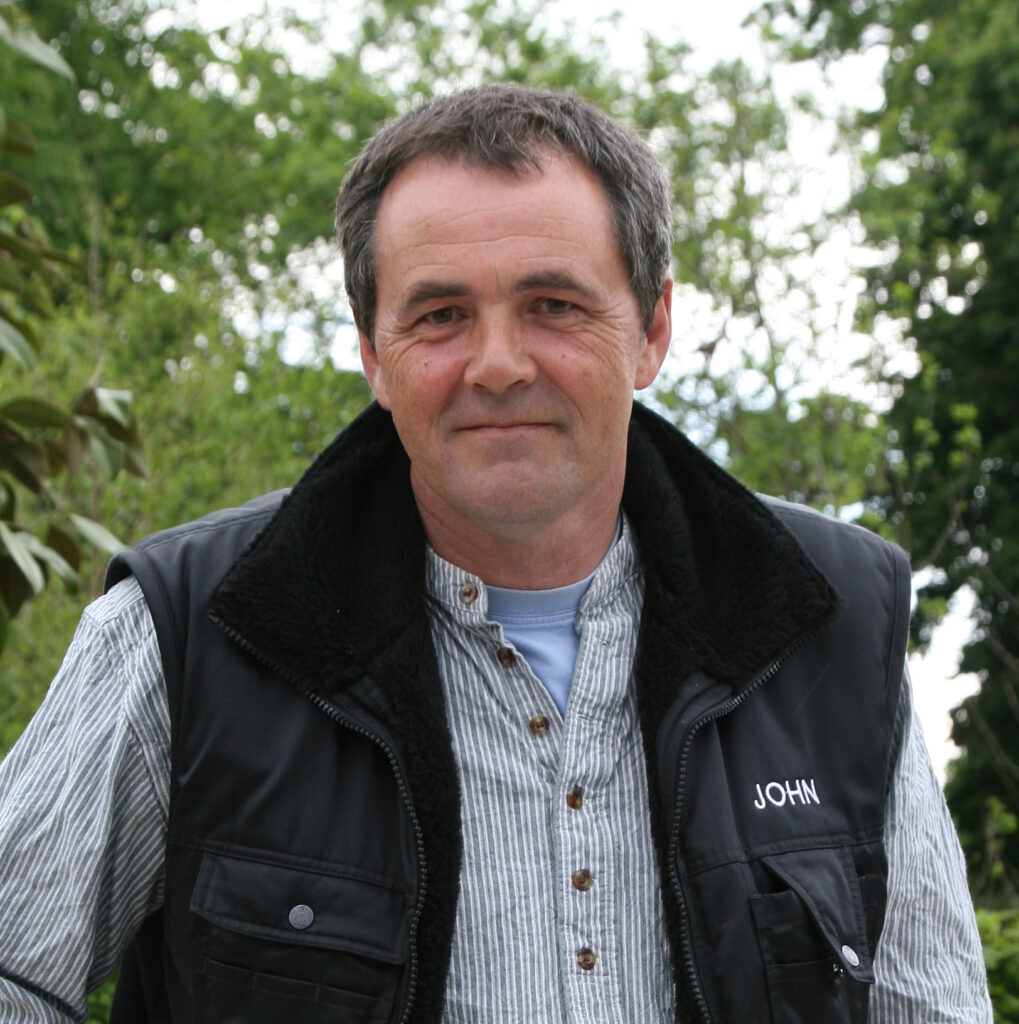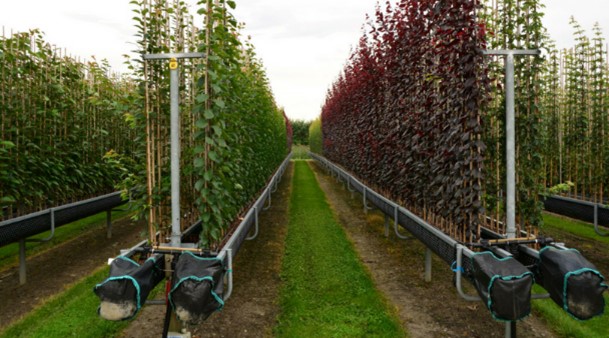Renowned tree specialist and owner of Annaveigh Plants, John Murphy put an edge on his grafting knife and a new spin on traditional methods of tree production. Methods that might hold the key to future production.
Having moved from the office three years ago into full-time production, I have started to think seriously about our planting stock. The future supply from overseas is a worry and even though our stock is contract grown, we still have issues. Thoughtful consideration also needs to be given to disease importing, carbon footprint, and Irish provenance for the species material, such as Oak. How much of this planting stock could we realistically supply ourselves, and could we grow it to an acceptable standard? Could grafting be the answer?
I have closely watched the development of the Air-Pot U system and the introduction of the slotted pot into tree propagation in Europe. Both systems are based on the air pruning of roots and it is possible, using either of these, to get a Betula jacquemontii up to 1.75-2m from a winter graft in one season. The resultant roots are extremely fibrous, and the possibility of root girdling is removed due to the air pruning. We plant around 6,000 young trees, from both systems, yearly and grafting is the main propagation technique employed to supply young plants for both growing methods.
A further reason to revisit grafting was my son, David, who expressed an interest in learning this skill after reading the excellent grafting book: ‘The Manual of Plant Grafting’ by Peter MacDonald. On the subject, I can also recommend ‘The Bench Grafters Handbook’ by Brian Humphrey. It has a great section on individual species requirements. In MacDonald’s book there is an interesting segment on the ancient history of grafting, and he comments on the unusual techniques used by the ancient Sabean people, ‘The branch that is to be grafted must be in the hands of a beautiful damsel, while a male person has disgraceful intercourse with her: during this, the woman grafts the branch into the tree’. This method has not endured the test of time, imagine how low productivity would be!
Twenty-seven years since I last grafted – and with my new Tina 605 knife in hand – I started to practice the various cuts and graft types, mostly whip and side grafts. It did not take me long to cut my thumb, but at least I got some practice before starting to teach David. I also soon found that things have changed since my time. When I asked about getting wax, I was informed that most grafters use wax tape instead, and dress other cut surfaces with a product called ‘Lax Balsam’. It turned out that the wax tape was handy and avoided melting wax day after day. If you ever use the tape, use the perforated type.
So, in mid-December, all set and wearing my new apron, I started with a simple whip graft of Sorbus ‘Sheerwater Seedling’ onto Irish provenance Sorbus aucuparia rootstocks, well-graded, and supplied by Jack in Fermoy Woodland Nurseries. The scion and rootstocks are tied using rubber grafting bands and the union is covered with wax tape to prevent drying out. There was something heartening about grafting Irish-produced scion wood from the nursery onto Irish rootstocks.
As the day passed, and after Grainne visited with the encouraging words, ‘Is that all you have done,’ I started thinking about the people from whom I had learned this ancient skill. Thanks to Prof. Dr. Donnchadh Mac Cárthaigh, one of Ireland’s most successful horticultural academics, we found ourselves north of Hamburg in Kordes Jungpflanzen after leaving UCD in 1988. This is a young-plant nursery specialising in the growing of 1lt liners in a massive range including all types of grafted stock, even Clematis. It’s well worth a visit, but do not get into a drinking session with Gunter Kordes. After months spent preparing rootstocks and scion wood, we were eventually allowed to sit at the grafting table with around eight very experienced grafters and four nursery stock apprentices. These were hard-working northern Germans, many of whom had lived through WW2, rebuilt Germany, and took no bullshit. Of course, there was Hans and Fritz on the crew, both in their early sixties, from whom we learned an enormous amount, and Helga in her late twenties was a graduate of the nursery apprentice scheme and helped us to understand the more technical aspects of aftercare. This apprenticeship scheme is still going and produces a reasonable stream of trained workers for the German nursery industry.
Four months later, with gorgeous late spring weather, I could not wait to get away from the grafting table, by this stage we were splitting stems of new clematis growth for scions, grafting them onto seedling stocks and tying with thin raffia. It is almost akin to doing surgery with an axe. But next season I could not wait for it to start again.
On returning to Ireland in the early 90’s, and through contact with Paddy Gleeson, Ireland’s most renowned Nursery Stock advisor and great tour organiser – “let’s do America again Paddy,” – we got an opportunity to take on a massive grafting program in Kildare using the not well-known Hot Pipe system for graft callousing. It’s a method by which individual graft unions are subject to heat for rapid callous production and healing and many versions are in use throughout the world today. It was quite successful and produced good stock for potting or planting, but the use of conventional pots back then added to a non-uniform growth not experienced with the modern Air-Pot U or slotted pots. The pots also led to root girdling in some species.
Any experience I have of graft aftercare has always depended on a supportive system where the humidity and temperature are controlled and usually bud growth happens early in the season. With only a 20-year-old walk-in tunnel in the veg garden, I had no choice but to go the supportive road. The bare root grafts were heeled into deep nursery crates, leaving the covered union above the substrate and stood down under a sandwich of fleece, plastic, fleece, and shading. The fleece below the plastic prevents dripping onto the grafts. After six weeks, most grafts showed good callus development and we have started to pot the new trees into 3lt slotted pots that are stood down and covered with two layers of fleece and shading. The trick now is to ensure that scion growth is not pushed along too quickly for the new union to cope with moisture and nutrient flow.
During a recent call with Weit Rentes, we got talking about grafting and aftercare. He said that he always remembers his dad storing his finished grafts in an old septic tank under the house, as a precursor to the cold store. Today in Holland the use of cold storage is common. Once the grafts are finished, they are packed into plastic bags and crates and kept above two degrees. Callus production is extremely slow and bud burst is held back until required. Since the Air-Pot U system is outdoors, the grafts are taken out of store in April and planted 15cm apart in the troughs, which are waist height for easy working. In theory, this should give the grower a very uniform bud burst allowing caning and tying to be more programmed.
Our winter grafting included both easy and not-so-easy species. The easy ones – Sorbus and Crataegus – we did first, as they gave us both time to practice the knife work before tackling the Oak, Acer campestre, Betula, and Carpinus. The rootstocks used were a mix of 1+0 seedlings and 1+1 transplants, depending on the scion wood size. We used an apical whip graft where the scion and stock were of equivalent size and where the stock was larger, a full tongue side graft, mostly on Betula and Carpinus.
At David’s request, we included 1,000 hardwood cuttings in the experiment, consisting of Salix, Platanus, Acer freemanii, and rubrum types, The latter should only be grown from cuttings, as grafts onto Acer rubrum stocks have long term compatibility problems. Recent reading about hardwood cuttings revealed the use of plastic bags and controlled temperature as a method of producing root initials before potting. A practice in use at Frank P. Matthews Nursery in the UK, another must-visit nursery for anyone interested in propagation. I can confirm from our experiment that only the Salix has so far shown any inclination of rooting, updates later. David’s already talking about building a Garnor Bin for hardwood cuttings.
Whether our experiment with 3,000 grafts works its way into our production system remains to be seen. Can we crack the growing of strong maidens in slotted pots? No matter what, it has been an enjoyable time spent passing on the skill to another generation – seeing David experiencing the same wonderment I did 35 years ago when I watched my first grafts callus.
As we seek to find ways to meet the needs of the future, we should first look to the past. The traditional grafting methods, with a modern twist, may well provide the answer.
For more information and video’s visit volentis.com one of Holland’s foremost tree nurseries and the birthplace of the Air-Pot U system.

John Murphy is the owner and operator of Annaveigh plants and is one of Ireland’s most experienced and respected nurserymen. For more information visit www.annaveigh.com |






